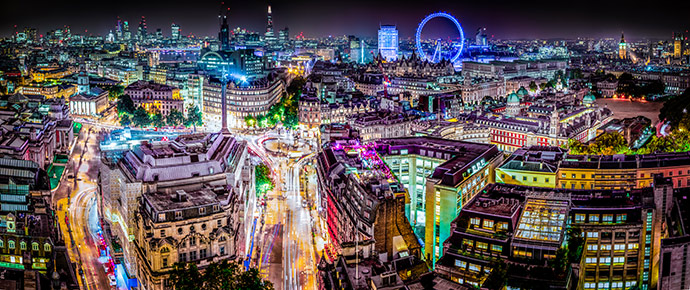Night Fever: Remedying unbalanced urban masterplans

Diagnosing the issue
Urban masterplans are typically holistic exercises shaped by a wide range of experts – among them urban designers, architects, planners, engineers, sustainability specialists, economists, and engagement advisors.
The strongest masterplans balance physical and environmental considerations with economic, demographic, and practical delivery concerns to realise Triple Bottom Line outcomes for areas. They also incorporate non-physical interventions that complement and activate physical changes to deliver vibrant and functioning places.
Even the most comprehensive masterplans, however, primarily focus on daytime rather than nighttime activity. This is despite the fact that nighttime activity, which refers to all activity between 6pm and 6am, is an important part of the identity, vibrancy and economies of most urban centres and, crucially, requires attention to support high street regeneration and evolution. This is highlighted by MHCLG in their response to the well-known Portas High Street Review:
“The future of high streets is not just about retail. People care about high streets because they are the centres of their community. Government wants to see vibrant, viable high streets where people live, shop, use services and spend their leisure time, including in an evening and night time economy”.
It is also reflected in the Greater London Authority’s (GLA) recent publication on Adaptive Strategies for High Streets and Town Centres:
“Londoners do not operate within a 9am–5pm framework. The city is now recognised as having a 24-hour economy, with activity happening around the clock. There are 1.6 million night-time workers in London. This is a third of the capital’s employees, and half of night bus journeys are for work. The largest sectors for night work are health and social care, followed by cultural and leisure, in which half of employees work nights. High streets and town centres must adapt to reflect this, to better serve local people and exploit opportunities for business innovation”.
Central to these assertions is that nighttime activity extends beyond the traditional view of the ‘night time economy’ (i.e. pubs, bars and restaurants) and includes retail, food, public services, community centres, events and the operation of offices and commercial premises outside of standard office hours.
Some practitioners understand the benefits of encouraging night time activity and have responded by developing night time strategies for their places (see Manchester, Waltham Forest, the Olympic Park, Newcastle and Leeds). Few places, however, give sufficient credence to both night and daytime activity in their large-scale place-based masterplans and strategies, despite the importance of night time activity to residents, high street resilience and, increasingly, occupiers looking to attract workers back to the office.
Treating the symptoms
There are many ways to better integrate nighttime considerations into urban masterplans, ranging from tactical public realm interventions to introducing event programmes and night friendly uses. This is highlighted in the GLA’s new guidance document for supporting night time activity in urban centres – they define six intervention areas to consider:
- 1. Public Realm (e.g., lighting, materials, foliage, wayfinding, visibility, sightlines, natural surveillance etc).
- 2. Civic and Public Life (e.g., cultural uses, youth centres, creative workspaces, leisure uses, events, lighting open spaces etc).
- 3. Communities and Planning (e.g., land use planning, night use clustering, streamlined licencing, flexible licensing, night and daytime ‘bridges’ etc).
- 4. Management and Social Responsibility (e.g., additional street cleansing, street wardens, safe havens, streamlined noise complaint processes, late night levy etc).
- 5. Economy After 6pm (e.g., extended opening, regular events, nested uses, nighttime innovation grants, pop ups, meanwhile uses, place promotion etc).
- 6. Public/Private Interface (e.g., consolidated waste collection, appropriate servicing, design guidance, lighting guidance, active frontages, streetside dining, etc).
The guidance provided is supported by a range of domestic and international examples to provide inspiration and learning (e.g. Haringey’s Green Lane Lighting Strategy, Merton’s Art Space Project, Helsinki’s Public Light Art, Uppsala’s Giraffe Play Ground, Paris’s Night Owl Committee, Westminster’s Night Stars, Sydney’s Night Time Diversification Grants, Parramatta’s Amplify Events and Bexley’s Erith Lighthouse).
We believe that interventions like these should be considered as part of urban masterplans, particularly where nighttime activity has traditionally been an important part of a place’s economic identity and where the demographic characteristics of a place lend themselves to supporting a stronger night time economy.
Addressing the root cause
Potentially the most impactful intervention, however, is for practitioners to work closely with businesses, services and anchor institutions, as well as Council and regulatory services, to extend their opening hours. Introducing new activity and uses can be more difficult than utilising valuable assets that already exist.
While this cannot be more than a recommendation in urban masterplans, these documents can enable extended opening hours by putting the right conditions in place to give consumers a reason to use urban centres later in the evening, and to give businesses, services and anchor institutions the confidence to open later. For example, masterplans can:
- Introduce new nighttime anchors to encourage other businesses to stay open later (e.g. theatres, music venues, cinemas etc).
- Cluster nighttime uses to create viable pockets of evening or late-night activity.
- Identify locations for enhanced and targeted operational management.
- Include lighting strategies to make places feel safer and more welcoming to consumers.
- Suggest new outdoor event spaces, with associated programming, to boost evening footfall and business opportunities.
- Recommend enhanced wayfinding to make nighttime assets more visible.
- Shape planning and licensing policies to encourage innovative use of commercial premises (e.g. nesting of both day and night time uses).
- Make the case for investing in the management and promotion of nighttime activity.
Places that are able to put the right conditions in place and can then encourage stakeholders to open later, are likely to reap the benefits and build long-term resilience. There is a significant amount of evidence showing that a combination of carefully planned interventions alongside longer opening hours can boost urban centres and help address the dreaded ‘night fever’.
- Longer opening can boost footfall: Newcastle’s innovative ‘Alive After Five’ programme, which involved working with businesses to extend their opening hours from 5pm to 8pm, attracted over 11.6m additional visitors to come to the city centre between 2011 and 2016.
- Longer opening can boost the economy: Sydney’s ‘lock out laws’, which involved restricting opening hours in certain areas, led to a 20% decline in businesses turnover and a 17.7% decline in employment in the affected areas between 2013 and 2015.
- Longer opening can support inclusivity: Data from the NHS shows that 40% of GP appointments that are available outside of ‘typical’ opening hours are used by patients from the poorest fifth of the population and that women dominate the uptake.
- Longer opening can catalyse tourism: London’s 2016 Lumiere Festival, which involved curating light art installations at night, alongside extended opening hours, attracted 1.4 million visitors generating an economic impact of around £5.7m through local spending and multiplier effects.
- Longer opening can enable flexible lifestyles: PureGym estimate that 24% of their members train between 10pm and 4am illustrating the value of opening services later to support 24-hour lifestyles.
Patrick Ransom is an Associate Director in Avison Young’s London Planning, Development and Regeneration team. He is an expert in town centre regeneration and has led strategy work for Watford, Dereham, Northolt, Swaffham, Streatham, Watton and South Norwood town centres among others. He has also previously worked with the Mayor of London and London Night Czar to provide research to underpin their 24-Hour London programme, with a specific focus on understanding the costs and benefits of longer opening hours.

* Avison Young is not responsible for the content of external sites.
